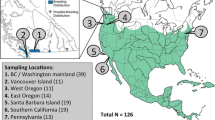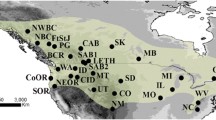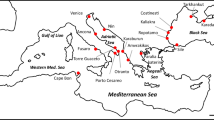Abstract
New methods of analysing genetic data provide powerful tools for quantifying dispersal patterns and reconstructing population histories. Here we examine the population structure of the bumblebee Bombus hortorum in a model island system, the Western Isles of Scotland, using microsatellite markers. Following declines in other species, B. hortorum is the only remaining long-tongued bumblebee species found in much of Europe, and thus it is of particular ecological importance. Our data suggest that populations of B. hortorum in western Scotland exist as distinct genetic clusters occupying groups of nearby islands. Population structuring was higher than for other bumblebee species which have previously been studied in this same island group (Fst = 0.16). Populations showed significant isolation by distance. This relationship was greatly improved by using circuit theory to allow dispersal rates to differ over different landscape features; as we would predict, sea appears to provide far higher resistance to dispersal than land. Incorporating bathymetry data improved the fit of the model further; populations separated by shallow seas are more genetically similar than those separated by deeper seas. We argue that this probably reflects events following the last ice age when the islands were first colonized by this bee species (8,500–5,000 ybp), when the sea levels were lower and islands separated by shallow channels would have been joined. In the absence of significant gene flow these genetic clusters appear to have since diverged over the following 5,000 years and arguably may now represent locally adapted races, some occurring on single islands.



Similar content being viewed by others
References
Alberto F (2009) MsatAllele_1.0: an R packge to visualize the binning of microsatellite alleles. J Hered 100:394–397
Becker JJ, Dandwell DT, Smith WHF, Braud J, Binder B, Depner J, Fabre D, Factor R, Von Rosenberg J, Wallace G, Weatherall P (2009) Global bathymetry and elevation data at 30 arc seconds resolution: SRTM30_PLUS. Mar Geodesy 32:355–371
Beerli P (2006) Comparison of Bayesian and maximum likelihood inference of population genetic parameters. Bioinformatics 22:341–345
Beerli P (2008) Migrate version 3.0—a maximum likelihood and Bayesian estimator of gene flow using the coalescent. Distributed over the internet at http://popgen.scs.edu/migrate.html
Belkhir K, Borsa P, Chikhi L, Raufaste N, Bonhomme F (2004) GENETIX 4.05, logiciel sous Windows TM pour la génétique des populations. Laboratoire Génome, Populations, Interactions, CNRS UMR 5000, Université de Montpellier II, Montpellier, France
Carvell C, Westrich P, Meek WR, Pywell RF, Nowakowski M (2006) Assessing the value of annual and perennial forage mixtures for bumblebees by direct observation and pollen analysis. Apidologie 37:326–340
Charman TG, Sears J, Green RE, Bourke AFG (2010) Conservation genetics, foraging distance and nest density of the scarce Great Yellow Bumblebee (Bombus distinguendus). Mol Ecol 19:2661–2674
Cushman SA, McKelvey KS, Hayden J, Schwartz MH (2006) Gene flow in complex landscapes: testing multiple hypotheses with causal modeling. Am Nat 168:486–499
Darvill B, Ellis J, Lye GC, Goulson D (2006) Population structure and inbreeding in a rare and declining bumblebee, Bombus muscorum (Hymenoptera: Apidae). Mol Ecol 15:601–611
Darvill B, Lye GC, Goulson D (2007) Aggregations of male Bombus muscorum (Hymenoptera: Apidae) at mature nests. Incestuous brothers or amorous suitors? Apidologie 38:518–524
Darvill B, O’Connor S, Lye GC, Lepais O, Goulson D (2010) Cryptic differences in dispersal lead to differential sensitivity to habitat fragmentation in two bumblebee species. Mol Ecol 19:53–63
Dixon P (2003) VEGAN, a package of R functions for community ecology. J Veg Sci 14:927–930
El Mousadik A, Petit RJ (1996) High level of genetic differentiation for allelic richness among populations of the argan tree [Argania spinosa (L) Skeels] endemic to Morocco. Theor Appl Genet 92:832–839
Ellis JS, Knight ME, Darvill B, Goulson D (2006) Extremely low effective population sizes, genetic structuring and reduced genetic diversity in a threatened bumblebee species, Bombus sylvarum (Hymenoptera: Apidae). Mol Ecol 15:4375–4386
Esselstyn JA, Brown RM (2009) The role of repeated sea-level fluctuations in the generation of shrew (Soricidae: Crocidura) diversity in the Philippine Archipelago. Mol Phyl Evol 53:171–181
Estoup A, Scholl A, Pouvreau A, Solignac M (1995) Monoandry and polyandry in bumble bees (Hymenoptera–Bombinae) as evidenced by highly variable microsatellites. Mol Ecol 4:89–93
Estoup A, Solignac M, Cornuet JM, Goudet J, Scholl A (1996) Genetic differentiation of continental and island populations of Bombus terrestris (Hymenoptera: Apidae) in Europe. Mol Ecol 5:19–31
Falush D, Stephens M, Pritchard JK (2003) Inference of population structure using multilocus genotype data: linked loci and correlated allele frequencies. Genetics 164:1567–1587
Faubet P, Waples RS, Gaggiotti OE (2007) Evaluating the performance of a multilocus Bayesian method for the estimation of migrtion rates. Mol Ecol 16:1149–1166
Goudet J (1995) FSTAT (Version 1.2): a computer program to calculate F-statistics. J Hered 86:485–486
Goulson D, Hanley ME, Darvill B, Ellis JS, Knight ME (2005) Causes of rarity in bumblebees. Biol Cons 122:1–8
Goulson D, Hanley ME, Darvill B, Ellis JS (2006) Biotope associations and the decline of bumblebees (Bombus spp.). J Ins Cons 10:95–103
Goulson D, Lye GC, Darvill B (2008a) Decline and conservation of bumblebees. Ann Rev Entomol 53:191–208
Goulson D, Lye GC, Darvill B (2008b) Diet breadth, coexistence and rarity in bumblebees. Biodiv Conserv 17:3269–3288
Holehouse KA, Hammond RL, Bourke AFG (2003) Non-lethal sampling of DNA from bumble bees for conservation genetics. Insect Soc 50:277–285
Jones OR, Wang J (2009) COLONY: a program for parentage and sibship inference from multilocus genotype data. Mol Ecol Resour 10:551–555
Jordan JT, Smith DE, Dawson S, Dawson AG (2010) Holocene relative sea-level changes in Haris, Outer Hebrides, Scotland, UK. J Quat Sci 25:115–134
Kraus FB, Wolf S, Moritz RFA (2009) Male flight distance and population substructure in the bumblebee Bombus terrestris. J Anim Ecol 78:247–252
Legendre P, Legendre L (1998) Numerical ecology, 2nd English edn. Elsevier, Amsterdam, The Netherlands
Lepais O, Darvill B, O’Connor S, Osborne J, Sanderson RA, Cussans J, Goffe L, Goulson D (2010) Estimation of bumblebee queen dispersal distances using sibship reconstruction method. Mol Ecol 19:819–831
Lozier JD, Cameron SA (2009) Comparative genetic analyses of historical and contemporary collections highlight contrasting demographic histories for the bumble bees Bombus pennsylvanicus and B. impatiens in Illinois. Mol Ecol 18:1875–1886
McRae BH (2006) Isolation by resistance. Evolution 60:1551–1561
McRae BH, Beier P (2007) Circuit theory predicts gene flow in plant and animal populations. PNAS 104:19885–19890
Nei M (1987) Molecular evolutionary genetics. Columbia University Press, New York
Paradis E, Claude J, Strimmer K (2004) ‘APE: analyses of phylogenetics and evolution in R language. Bioinformatics 20:289–290
Pritchard JK, Stephens M, Donnelly P (2000) Inference of population structure using multilocus genotype data. Genetics 155:945–959
Pritchard JK, Wen X, Falush D (2009) Documentation for structure software: version 2.3. Department of Human Genetics, University of Chicago, Chicago, IL
R Developement Core Team (2009) R: a language and environment for statistical computing. R Foundation for Statistical Computing, Vienna, Austria
Rasmont P, Mersch P (1988) Première estimation de la dérive faunique chez les bourdons de la Belgique (Hymenoptera, Apidae). Annales de la Société Royale Zoologique de Belgique 118:141–147
Redpath N, Osgathorpe LM, Park KJ, Goulson D (2010) Crofting and bumblebee conservation: the impact of land management practices on bumblebee populations in northwest Scotland. Biol Cons 143:492–500
Rice WR (1989) Analyzing tables of statistical tests. Evolution 43:223–225
Ritchie W, Whittington G, Edwards KJ (2001) Holocene changes in the physiography and vegetation of the Atlantic littoral of the Uists, Outer Hebrides, Scotland. Trans R Soc Edinb Earth Sci 92:121–136
Rousset F (1997) Genetic differentiation and estimation of gene flow from F-statistics under isolation by distance. Genetics 145:1219–1228
Rousset F (2010) GENEPOP’007: a complete re-implementation of the GENEPOP software for Windows and Linux. Mol Ecol Resour 8:103–106
Schmid-Hempel R, Schmid-Hempel P (2000) Female mating frequencies in Bombus spp. from Central Europe. Insect Soc 47:36–41
Sladen FWL (1912) The Humble-bee, its life history and how to domesticate it. Including The Humble Bee (1892). Logaston Press,
Takahashi J, Ayabe T, Mitsuhata M, Shimizu I, Ono M (2008) Diploid male production in a rare and locally distributed bumblebee, Bombus florilegus (Hymenoptera, Apidae). Insect Soc 55:43–50
Truett GE, Heeger P, Mynatt RL, Truett AA, Walker JA, Warman ML (2000) Preparation of PCR-quality mouse genomic DNA with hot sodium hydroxide and tris (HotSHOT). BioTechniques 29:52–54
van der Loo MPJ (2010) Distribution based outlier detection for univariate data. Discussion paper, Statistics Netherlands, The Hague
Van Oosterhout C, Hutchinson WF, Wills DPM, Shipley P (2004) MICRO-CHECKER: software for identifying and correcting genotyping errors in microsatellite data. Mol Ecol Notes 4:535–538
Wang J (2004) Sibship reconstruction from genetic data with typing errors. Genetics 166:1963–1979
Waters J, Darvill B, Lye GC, Goulson D (in press) Niche differentiation of a cryptic bumblebee complex in the Western Isles of Scotland. Ins Cons Div
Weir BS, Cockerham CC (1984) Estimating F-statistics for the analysis of population structure. Evolution 38:1358–1370
Williams PH, Osborne JL (2009) Bumblebee vulnerability and conservation world-wide. Apidologie 40:367–387
Wilson GA, Rannala B (2003) Bayesian inference of recent migration rates using multilocus genotypes. Genetics 163:1177–1191
Zayed A, Packer L (2005) Complementary sex determination substantially increases extinction proneness of haplodiploid populations. PNAS 102:10742–10746
Acknowledgments
This work was partly funded by the Leverhulme Trust. Some of the work was carried out using the resources of the Computational Biology Service Unit from Cornell University which is partially funded by Microsoft Corporation.
Author information
Authors and Affiliations
Corresponding author
Rights and permissions
About this article
Cite this article
Goulson, D., Kaden, J.C., Lepais, O. et al. Population structure, dispersal and colonization history of the garden bumblebee Bombus hortorum in the Western Isles of Scotland. Conserv Genet 12, 867–879 (2011). https://doi.org/10.1007/s10592-011-0190-4
Received:
Accepted:
Published:
Issue Date:
DOI: https://doi.org/10.1007/s10592-011-0190-4




